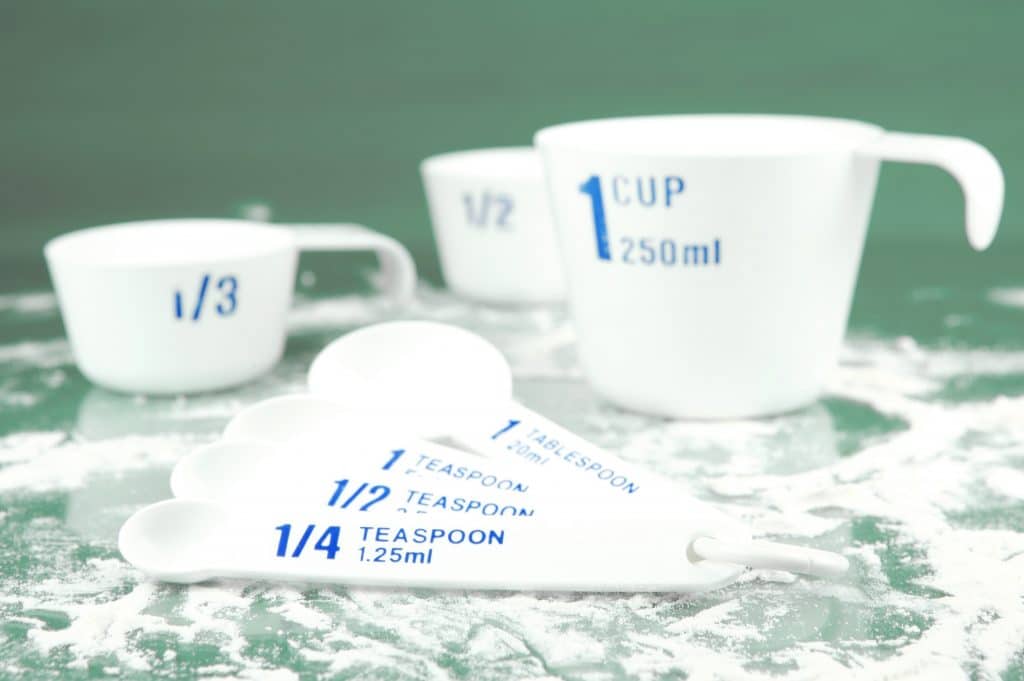Measuring correctly is the most important kitchen skill you can have. There is a major difference in measuring for cooking and when you measure for baking. When it comes to cooking you have a little more freedom. While cooking, you can add a dash of this and a dash of that. Baking requires a lot more accuracy. In this article I will give you some tips on how to measure correctly.
Lets start with the tools you will need and how to choose them. You need to make sure you’re using tools that are commercially made. This will ensure that all tools are the exact size that is displayed on the utensil. For dry ingredients you will need to use graduated measuring cups and measuring spoons.
You cannot use the spoon you use for tea even though it may look like the same size as your measuring spoon it might be slightly off which will turn your amazing recipe into a disaster. For liquid ingredients you want to use a glass or plastic cup that has a pouring sprout.
Below is a basic guide to help you measure for baking.
The graduated measuring cups come in: ¼ cup, 1/3 cup, ½ cup,1 cup and 2 cup sizes. For liquid measuring cups it usually comes in 2 cups and 4 cups. The measuring spoons range in sizes from 1/8 teaspoon, ¼ teaspoon, ½ teaspoon, 1 teaspoon, and 1 tablespoon.
Flour: Before measuring you want to stir the flour. This helps prevent any packing of the flour which will give you more than you really want. Using a large spoon put some flour in the cup. Don’t shake the cup. Take the back of a butter knife or a straight edge and level off the flour evenly from the top edge of the cup. You don’t want to scoop the flour out. You will end up getting way more flour than you need.
Baking powder and baking soda: You want to stir the container first. When using a measuring spoon, lightly scoop it out of the container. You the same butter knife and level off evenly from the top edge of the spoon.
Liquid ingredients: You need to measure liquid at eye level. Take the liquid measuring cup and pour the liquid into the cup. Bend over to see if the liquid is at the line and not below or above.
Semi liquid ingredients: These ingredients are like peanut butter, yogurt, and sour cream. These ingredients you have to use the graduated measuring cups. Due to them being much thicker than liquid. Make sure to level off each ingredient with the back of the butter knife.
Sugar: You can scoop out the sugar with the measuring cup or spoon. Just make sure you level off the from the top with that butter knife.
Brown sugar: This ingredient needs to be packed in the measuring cup or spoon. The sugar should be the same shape as the utensil your using.
Powdered sugar: Powdered sugar needs to be sifted to make sure all lumps are removed. You can just spoon the sugar in the measuring cup and level off with the back on the butter knife.
Shortening and solid fats: The butter and margarine already have the measuring amounts on them so those are easy to measure. Shortening needs to be packed into the cups and making sure all air bubbles are out. To ensure these ingredients are easily removed you can spray the measure cup or spoon with cooking spray or use a little bit of vegetable oil.
Liquid/ Dry Ingredients in spoons: Since you are using such a small amount make sure you don’t measure over the bowl. You might get way too much of the liquid. Dry ingredients still need to measure correctly you cannot have the spoon overflowing. You also need to use the back of that butter knife again to level off. For baking soda and baking powder your success in baking is critical so make sure all ingredients are measured correctly.
Chopped Ingredients: Make sure you pay close attention if the ingredient is minced, chopped, or diced. Put the ingredient in the cup and level off the top.
When it comes to cooking soups, meats, and casseroles you can vary the amount and fix it at the end. When you bake breads, cookies, pies, and cakes measuring correctly is crucial to the success of your recipe. I hope these tips helped you create an awesome sweet treat!



Leave a Reply